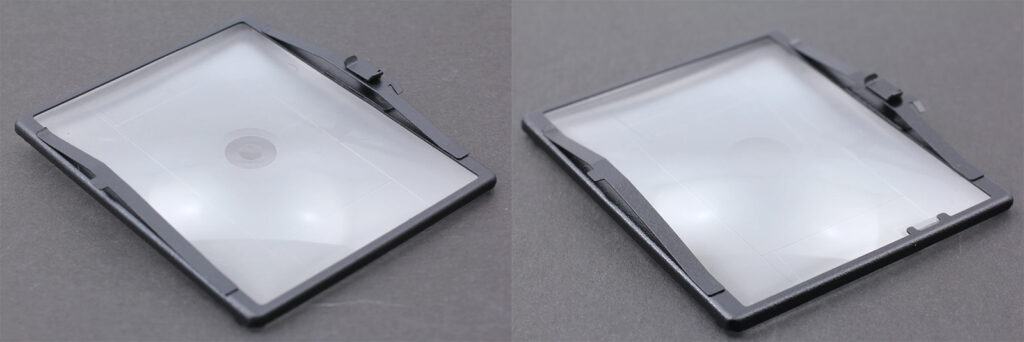The Bronica ETR System incorporates a range of different focusing screens, some catering to the preference or specific work of the photographer, and others supporting the range of 35mm film backs that available as a part of the system. The screens are made of plastic, which unfortunately renders them highly susceptible to scuffs and scratches if not properly handled or adequately protected.
Types & Variants
Seven types of focusing screen were released throughout the lifespan of the Bronica ETR System, with three minor variants released with the ETRSi model.
Split-image Microprism
Generation: ETR, ETRS, ETRSi (Tamron)
This is the standard focusing screen for ETR and ETRS model cameras. It includes a split-image rangefinder spot, with the split oriented at 45-degree diagonal, which is surrounded by a microprism ring and, finally, a full-area matte screen plus Fresnel lens.
Matte (also Full Matte or All Matte)
Generation: ETR, ETRS, ETRSi
This is the most basic focusing screen available for the ETR System, and became the standard screen for ETRSi model cameras. The screen has a matte center with a full-area Fresnel lens outside the center spot.
Grid Lines
Generation: ETR (since ETR-C), ETRS, ETRSi
Includes a full area matte with center spot, plus vertical & horizontal grid lines with super-slide frame indicated. Note: Gridlines are etched through the center spot, despite the diagram shown on some models indicating otherwise. Also, ETR and earlier ETRS boxes show a diagram of the screen without the center spot, however the center spot is still present.
Microprism Spot
Generation: ETRS
This screen includes a microprism spot plus full area Fresnel lens. It does not seem to have been popular, as it is quite rare to find, and was only available with the ETRS generation of cameras.
Split-image
Generation: ETRS
A diagonally oriented split-image rangefinder spot plus full-area Fresnel lens. Another unpopular variation which is rare to find, and was only available with the ETRS generation of cameras.
Split-image Microprism 135
Generation: ETRS Mk-II
This screen is the same as Split-image Microprism, with the addition of guidelines for shooting 35mm standard or “wide”, for use with the 135-N or 135-W film backs respectively. Guidelines are etched on the back of the screen.
Matte 135
Generation: ETRS Mk-II, ETRSi
The same as the Full Matte screen, with the addition of guidelines for shooting 35mm standard or “wide”, for use with the 135-N or 135-W film backs respectively. Guidelines are etched on the back of the screen.
Split-image (horizontal variant)
Generation: ETRSi (Bronica)
Similar to the Split-image screen, but with a horizontal instead of diagonal split. Another unpopular variant, although easier to find, the horizontal split was later reverted to a diagonal split for Tamron produced ETRSi models.
Split-image Microprism (horizontal variant)
Generation: ETRSi (Bronica)
A horizontal split variant of the Split-image Microprism screen. Also unpopular, the horizontal split was later reverted to a diagonal split for Tamron produced ETRSi models.
Split-image Microprism 135 (horizontal variant)
Generation: ETRSi (Bronica)
A horizontal split variant of the Split-image Microprism 135 screen, for use with the 135-N and 135-W film backs. Guidelines are etched on the back of the screen. This final horizontal split variant was also reverted to a diagonal split for Tamron produced ETRSi models.
Generational Differences
Although focusing screens were produced across all generations of ETR System cameras, there is only one obvious difference, which distinguishes ETRSi generation screens from all earlier screens. These newer screens include two additional metal tabs on the lower left side, which frame the battery check indicator LED for the camera body.
Despite this minor change, there are no incompatibilities between any E or Ei generation focusing screen and any of the ETR system bodies.

Packaging
Focusing screens were provided in a small cardboard box, labelled “Focusing Screen-E” (for ETR and ETRS generation) or “Focusing Screen-Ei” (for ETRSi generation). The box was layered with foam, and the screen wrapped in tissue paper. A small sticker on the bottom side of the packaging denoted the screen type using a diagram (and numbers for 135 style screens).

Cleaning
Be very careful attempting to clean an ETR focusing screen – they are made of plastic and notoriously easy to scuff and scratch. Always attempt to clean any dust first with a rocket blower (don’t blow on it, your saliva may stain the screen). If you really must, a damp lens cleaning cloth can be very gently wiped over the surface of the screen. Don’t expect to remove scuffs and scratches from the Fresnel rings – you’ll need to learn to live with these, or purchase a better quality replacement.
Prevention is the best cure with these delicate components – never store your camera with an exposed screen (keep a viewfinder attached at all times). If you have a spare screen, keep if safely stored between foam layers and tissue paper. Ideally, wear cotton gloves when handling or changing screens, as your sweat and skin oils can also mark the screen.